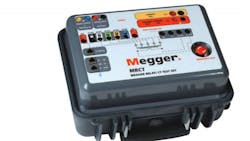Current Transformer Test Set Is Compact and Versatile
Testing speed, which significantly increases productivity and cuts costs, is a key benefit of Megger’s new compact MRCT current transformer (CT) test set. This unit also offers enhanced measuring accuracy to support the testing of metering-class CTs and can optionally be configured to provide integrated facilities for testing single-phase protection relays.
The MRCT can be supplied for use with the Megger STVI touch-screen interface, which has a large high-resolution color display, or with a standard laptop running Megger’s PowerDB software. It is the smallest and lightest 2 kV test set of its type currently available, and it uses patented technology to perform simultaneous measurements on up to 10 taps, thereby reducing test times by as much as 20% for multi-ratio CTs.
The test set connects directly to multi-ratio CTs and, at the push of a button, automatically performs a comprehensive sequence of tests, including saturation, ratio, polarity, winding resistance and insulation, thereby providing further time savings. No changes of connections are needed during the test sequence.
Grouped testing is supported with automatic demagnetization and calculation of ratio errors, knee points and saturation curves. Facilities for insulation resistance testing at 500 V and 1,000 V are also built in.
In addition to facilities for automatic testing of single- and multi-ratio CTs of all types, the MRCT test set also makes extensive provision for manual CT testing. The results from both automatic and manual tests can be stored in a high-capacity internal memory for subsequent download to a PC running PowerDB, which provides a wide range of reporting options.
As an option, the MRCT test set can be configured to include the functionality needed to test most commonly used types of single-phase protection relay. When used in this way, the instrument offers a current channel rated at up to 30 A @ 200 VA continuous and up to 60 A @ 300 VA for short periods. The voltage channel can provide a variable output of 0 to 30/150/300 V at 150 VA or can be configured as a second current channel to allow the testing of differential relays.
